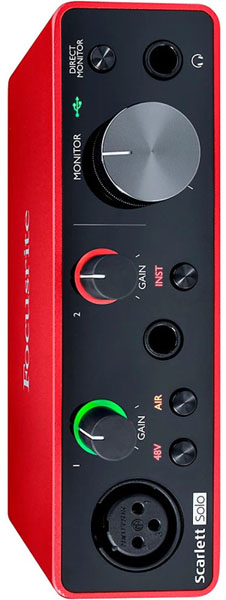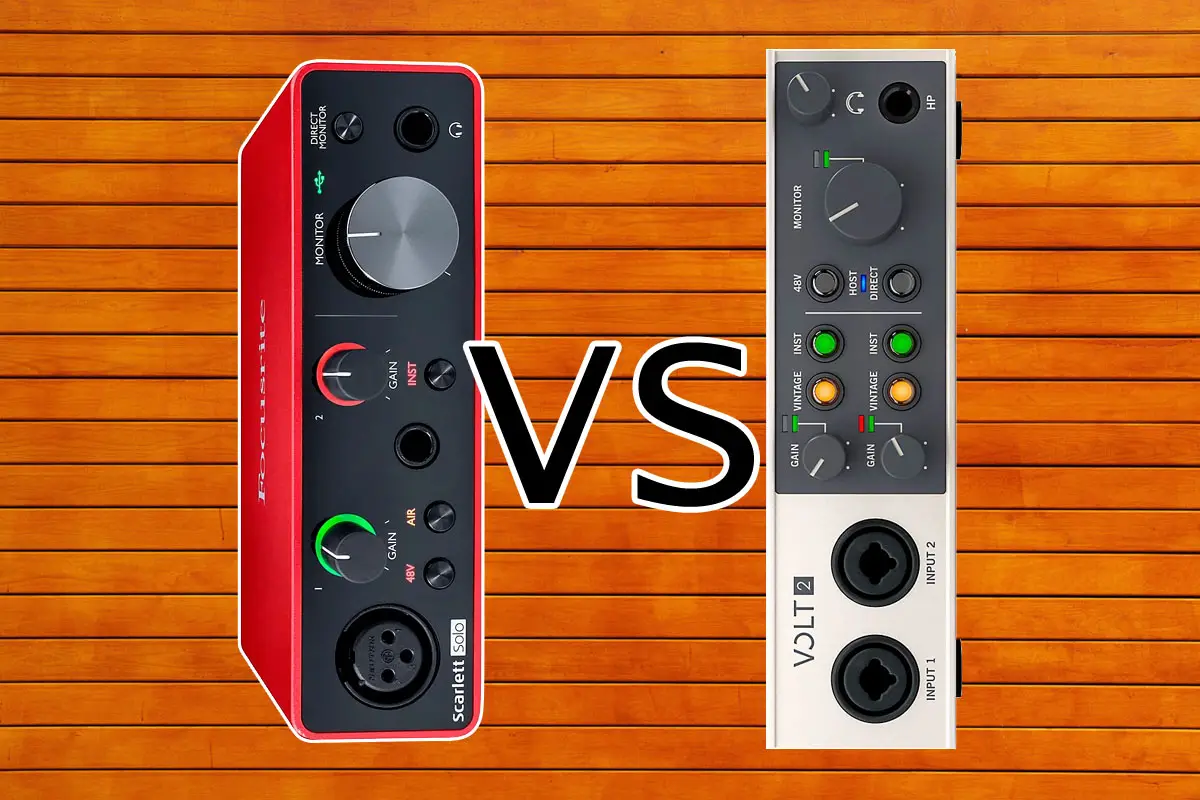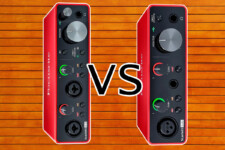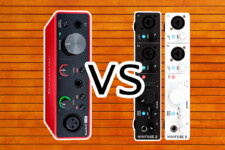Focusrite Scarlett Solo 3rd Gen vs UA Volt2: Which Interface Is Best?
If you are a guitarist who wants to record your music at home, you might be interested in two of the most popular and affordable audio interfaces on the market: the Focusrite Scarlett Solo 3rd Gen and the UA Volt 2. Both of these devices are designed to offer high-quality recording and playback for guitars, microphones, and other instruments.
The Focusrite Scarlett Solo 3rd Gen is a 2-in/2-out audio interface that features a mic preamp with Air mode, an instrument input with high headroom, and a direct monitor switch. The Universal Audio Volt 2 is a 2-in/2-out audio interface that features a Unison mic preamp with Realtime Analog Classics plug-ins, an instrument input with variable impedance, and a monitor mix knob. Both of these devices are USB-powered and compatible with most DAWs and operating systems.
But which one has the edge over the other? In this article, we will compare the features, performance, and price of these two audio interfaces, and help you decide which one is the best choice for you.

A Quick Look
If you want a compact and reliable audio interface that can deliver high-quality sound for your guitar or microphone, you may want to choose the Focusrite Scarlett Solo 3rd Gen. It has a USB-C port that can work with any device with a USB-A or USB-C port. It also has a mic preamp with Air mode that gives recordings a brighter and more open sound, and an instrument input with high headroom that can handle hot pickups without clipping.
If you want a powerful and versatile audio interface that can offer more options and flexibility for your guitar or microphone recording and playback, you may want to choose the UA Volt2. It has a Unison mic preamp that lets you emulate the sound of classic analog mic preamps, and an instrument input with variable impedance that lets you adjust the tone and feel of your instrument. It also has a monitor mix knob that lets you blend your input signal with the playback from your DAW or other software.

Focusrite Scarlett Solo 3rd Gen
- Mobile-ready, bus-powered, 2-in/2-out USB-C.
- Record at up to 24-bit/192kHz resolution.
- One XLR input with mic preamp, and one high headroom instrument input.
- Two balanced 1/4″ TRS main outputs.
- Switchable Air mode that gives recordings a brighter and more open sound.
- Unique halo level indicators that show you the input level and signal clipping.
- A direct monitor circuit that lets you monitor your input with low latency.
- 48V Phantom power switch for condenser microphones.

Universal Audio Volt 2
- Bus-powered 2-in/2-out USB-C audio interface.
- Record at up to 24-bit/192kHz resolution.
- Two combo mic/line/instrument inputs with Unison mic preamps.
- One instrument input with variable impedance.
- Two balanced 1/4-inch TRS main outputs.
- Monitor mix knob for blending your input signal with the playback from your DAW or other software.
- Selectable Vintage Preamp Mode for tube-like dynamic saturation and clipping.
- MIDI In/Out ports for connecting keyboards and other MIDI gear.
- 48V Phantom power switch for condenser microphones.
Price Comparison
The UA Volt 2 is more expensive than the Focusrite Scarlett Solo 3rd Gen, as you might expect from its advanced features and design. The UA Volt 2 has a recommended retail price of $189, but you can find it online for around $149. The Focusrite Scarlett Solo 3rd Gen has a recommended retail price of $129.99, but you can find it online for around $99.99.
So, the price difference between the UA Volt 2 and the Focusrite Scarlett Solo 3rd Gen is not huge, considering what you get with each device. However, if you are on a tight budget or just want a simple and easy-to-use interface, you might prefer the Focusrite Scarlett Solo 3rd Gen. If you are willing to spend a bit more or want a more flexible and professional interface, you might prefer the UA Volt 2.
Common Features
Both the Focusrite Scarlett Solo 3rd Gen and the UA Volt2 have some common features that make them suitable for basic recording and playback tasks. Here are some of them:
- USB-C port: Both devices have a USB-C port that lets you connect them to your computer or mobile device. This allows you to record and play back audio with any software that supports USB audio.
- Headphone output: Both devices have a 1/4-inch headphone output that lets you monitor your sound with headphones. This is useful for avoiding feedback or noise from speakers when recording.
- Gain control: Both devices have a rotary knob that lets you adjust the gain level of the input channel. This affects the volume and tone of your instrument or microphone signal.
- LED indicator: Both devices have an LED indicator that shows you the status of the device. The Focusrite Scarlett Solo 3rd Gen has a green LED that lights up when the device is powered on, and a halo LED that changes color according to the input level and signal clipping. The UA Volt2 has a blue LED that lights up when the device is powered on, and a meter LED that shows the input level.
Focusrite Scarlett Solo 3rd Gen – Unique Features
- Air mode: This is a feature that adds brightness and openness to your recordings by emulating the sound of Focusrite’s original ISA mic preamp. This can enhance the clarity and detail of your vocals or acoustic instruments.
- High headroom: This is a feature that allows you to record loud instruments without clipping or distorting the signal. This can preserve the natural tone and dynamics of your electric guitar or bass guitar.
- Direct monitor switch: This is a feature that lets you hear your input signal directly from the device without any latency or delay. This can help you to perform better and avoid timing issues.
UA Volt2 – Unique Features
- Unison mic preamp: This is a feature that lets you use Realtime Analog Classics plug-ins to shape the sound of your microphone input. These plug-ins emulate the sound of classic analog mic preamps, such as the UA 610-B Tube Preamp & EQ, and adjust the impedance and gain staging of the device accordingly. This can give you more control and flexibility over your vocal or instrument recordings.
- Variable impedance: This is a feature that lets you use Realtime Analog Classics plug-ins to adjust the impedance of your instrument input. These plug-ins emulate the sound of different types of guitar amps and pedals, such as the Marshall Plexi Classic Guitar Amp and the Raw Distortion Guitar Pedal, and match the impedance of the device to the original hardware. This can affect the tone and feel of your electric guitar or bass guitar.
- Monitor mix knob: This is a feature that lets you blend your input signal with the playback from your DAW or other software. This can help you to balance your monitor mix and hear yourself better.
Sound Quality
Sound quality is one of the most important criteria when evaluating an audio interface. After all, you want your recordings to sound as good as possible, right? Well, both the Focusrite Scarlett Solo 3rd Gen and the UA Volt2 claim to offer high-quality sound, but there are some differences in their specifications and performance.
The Focusrite Scarlett Solo 3rd Gen has a bit depth of 24-bit and a sample rate of 192 kHz. This means that it can capture and reproduce up to 16,777,216 levels of amplitude and up to 96 kHz of frequency in digital audio. This is considered to be studio-quality sound, and it covers the human hearing range well. The UA Volt2 has the same bit depth and sample rate, so you will get the same quality sound with either audio interface.
However, there are some other factors that affect the sound quality of these two audio interfaces, such as their input impedance, signal-to-noise ratio, dynamic range, frequency response, harmonic distortion, and crosstalk. These are technical terms that measure how well an audio interface can handle different types of signals without introducing noise or distortion.
Based on their specifications , it seems that the UA Volt2 has slightly better performance than the Focusrite Scarlett Solo 3rd Gen in terms of these factors. For example, the UA Volt2 has a higher input impedance (5.4 kΩ vs 3 kΩ), a higher signal-to-noise ratio (117 dB vs 111 dB), a higher dynamic range (117 dB vs 111 dB), a wider frequency response (20 Hz to 100 kHz vs 20 Hz to 20 kHz), a lower harmonic distortion (0.0009% vs 0.001%), and a lower crosstalk (-115 dB vs -100 dB).
These differences might not be very noticeable to the average listener, but they might make a difference to some audiophiles or professionals who want the best possible sound quality from their audio interface.
The sound quality of these two audio interfaces also depends on other factors, such as the quality of your instrument, cables, speakers, headphones, and software. However, based on their specifications and reviews, it seems that the UA Volt2 has a slight advantage over the Focusrite Scarlett Solo 3rd Gen in terms of sound quality.
Compatibility
Another aspect that you might want to consider when choosing an audio interface is its compatibility with your computer, operating system, and software. You want an audio interface that works smoothly with your setup and does not cause any issues or conflicts.
The Focusrite Scarlett Solo 3rd Gen is a class-compliant device, which means that it does not require any drivers to work with most operating systems and software. It is compatible with Windows 7 or higher, Mac OS X 10.10 or higher, iOS 8 or higher, and Android 5.0 or higher. It also comes with a USB-C to USB-A cable that let you connect it to any USB port on your computer or mobile device.
The UA Volt2 is also a class-compliant device, but it requires a software application called UA Console to access some of its features and settings. It is compatible with Windows 10 or higher, Mac OS X 10.12 or higher, iOS 12 or higher, and Android 9 or higher. It also comes with a USB-C to USB-A cable that let you connect it to any USB port on your computer or mobile device.
Both of these audio interfaces are compatible with most DAWs and other audio software, such as Pro Tools, Logic Pro, Ableton Live, GarageBand, Audacity, Reaper, FL Studio, Cubase, and more. However, some users have reported some issues or glitches with certain software or operating systems, so you might want to check the compatibility before buying one of these devices.
Focusrite Scarlett Solo 3rd Gen Pros
- More affordable.
- Studio-quality sound, Low latency.
- Mic preamp with Air mode that gives recordings a brighter and more open sound.
- An instrument input with high headroom that can handle hot pickups without clipping.
- Direct monitor switch that lets you monitor your input with low latency.
Focusrite Scarlett Solo 3rd Gen Cons
- No direct MIDI input/output.
- No headphone volume control.
- Requires external power for phantom power.
Universal Audio Volt 2 Pros
- High build quality.
- High-resolution sound. Low latency.
- A Unison mic preamp that emulates the sound of classic analog mic preamps.
- An instrument input with variable impedance that lets you adjust the tone and feel of your instrument.
- A monitor mix knob that lets you blend your input signal with the playback from your DAW or other software.
Universal Audio Volt 2 Cons
- More expensive.
- Does not have direct monitor circuit.
- No pad switch to reduce the input level.
Which One Would You Choose?
As you can see, both the Focusrite Scarlett Solo 3rd Gen and the UA Volt2 have their strengths and weaknesses.
If you are looking for an affordable and easy-to-use audio interface that can handle basic recording and playback tasks for your guitar or microphone, you might want to go for the Focusrite Scarlett Solo 3rd Gen. It offers studio-quality sound, low latency, and a class-compliant interface that does not require any drivers or software. It also features a mic preamp with Air mode that gives recordings a brighter and more open sound, and an instrument input with high headroom that can handle hot pickups without clipping.
If you are looking for a high-quality and versatile audio interface that can offer more options and flexibility for your guitar or microphone recording and playback, you might want to go for the UA Volt2. It offers high-resolution sound, low latency, and a class-compliant interface that works with most operating systems and software.
The UA Volt 2 also comes with Analog Classics plug-ins, which allow you to emulate the sound of classic analog mic preamps through the Unison mic preamp, and adjust the tone and feel of your instrument through the variable impedance instrument input. It also features a monitor mix knob that lets you blend your input signal with the playback from your DAW or other software.
Both of these audio interfaces are capable of delivering good results for guitarists who want to record their music at home. However, if you want to have more control and versatility over your sound, you might want to invest in the Universal Audio Volt2.




